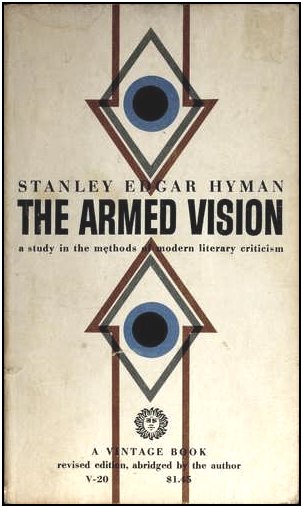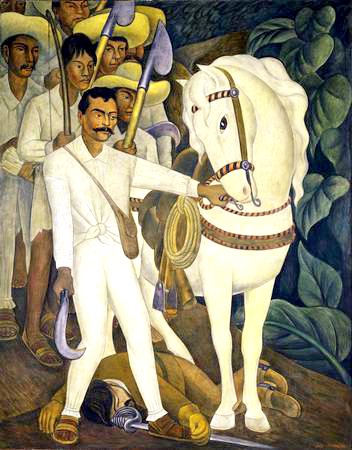"And behold, a white horse." — Johnny Cash
See also references to such a horse here.
"And behold, a white horse." — Johnny Cash
See also references to such a horse here.
The title, that of a novel by Arthur Koestler,
has appeared before in this journal.
The title was quoted in a Log24 note of
May 29, 2002 (G.K. Chesterton's birthday).
The link in Saturday evening's post to a Chesterton
essay suggested a further search that yielded
the following quotation—
Then silence sank. And slowly
Arose the sea-land lord
Like some vast beast for mystery,
He filled the room and porch and sky,
And from a cobwebbed nail on high
Unhooked his heavy sword.
— G. K. Chesterton,
The Ballad of the White Horse
This, together with some Log24 remarks
from 2004, suggests two images—

Above: A 1955 cover design by Robert Flynn.
The arrow theme also appears in a figure from
John Sealander's Road to Nowhere in the 2004
remarks:

The remarks quoting the Sealander image, from
March 5, 2004, were on mathematics and narrative.
Related material from a year later:
See an announcement, saved from March 16, 2005,
of a conference on mathematics and narrative that
was held in July 2005. Some context: Koestler's novel.
“Next to the bookcase stands a wooden cabinet with 24 drawers that looks like something you might have seen in a library decades ago, or perhaps in an old apothecary. The drawers are marked with the names of her novels or characters in the novels and crammed with indexed notes.
She pulls open a drawer marked ‘Lozen,’ the name of a main female character in another historical western novel, ‘The Ghost Warrior,’ and reads a few of the index tabs: ‘social relationships, puberty, death, quotes….'”
— From an article on Lucia St. Clair Robson in The Baltimore Sun by Arthur Hirsch, dated 1:31 p.m. EDT April 30, 2011*
From this journal later that same day —
 |
Robson’s most recent novel is Last Train from Cuernavaca .
“A corpse will be transported by express!”
— Malcolm Lowry, Under the Volcano
* Update of 5:48 AM EDT May 3—
The same article was also published with a different dateline— April 28.
Enthusiasts of synchronicity may lament the confusion, or they may
turn to April 28 in this journal for a different 24-part invention.
See also Art Wars, April 7, 2003 and White Horse .
"An acute study of the links
between word and fact"
— Nina daVinci Nichols
| Virginia | /391062427/item.html? | 2/22/2008 7:37 PM |
Johnny Cash:
"And behold,
a white horse."

Chess Knight
(in German, Springer)
"Liebe Frau vBayern,
mich würde interessieren wie man
mit diesem Hintergrund
(vonbayern.de/german/anna.html)
zu Springer kommt?"
Background of "Frau vBayern" from thePeerage.com:
Anna-Natascha Prinzessin zu Sayn-Wittgenstein-Berleburg
F, #64640, b. 15 March 1978Last Edited=20 Oct 2005
Anna-Natascha Prinzessin zu Sayn-Wittgenstein-Berleburg was born on 15 March 1978. She is the daughter of Ludwig Ferdinand Prinz zu Sayn-Wittgenstein-Berleburg and Countess Yvonne Wachtmeister af Johannishus. She married Manuel Maria Alexander Leopold Jerg Prinz von Bayern, son of Leopold Prinz von Bayern and Ursula Mohlenkamp, on 6 August 2005 at Nykøping, Södermanland, Sweden.
The date of the above "Liebe Frau vBayern" inquiry, Feb. 1, 2007, suggests the following:
From Log24 on
St. Bridget's Day, 2007:
The quotation
"Science is a Faustian bargain"
and the following figure–
Change

From a short story by
the above Princess:
"'I don't even think she would have wanted to change you. But she for sure did not want to change herself. And her values were simply a part of her.' It was true, too. I would even go so far as to say that they were her basis, if you think about her as a geometrical body. That's what they couldn't understand, because in this age of the full understanding for stretches of values in favor of self-realization of any kind, it was a completely foreign concept."
To make this excellent metaphor mathematically correct,
change "geometrical body" to "space"… as in
"For Princeton's Class of 2007"—
Review of a 2004 production of a 1972 Tom Stoppard play, "Jumpers"–
Related material:
Knight Moves (Log24, Jan. 16),
Kindergarten Theology (St. Bridget's Day, 2008),
and
“There is a pleasantly discursive treatment of Pontius Pilate’s unanswered question ‘What is truth?'”
— H. S. M. Coxeter, 1987, introduction to Richard J. Trudeau’s remarks on the “Story Theory” of truth as opposed to the “Diamond Theory” of truth in The Non-Euclidean Revolution
“A new epistemology is emerging to replace the Diamond Theory of truth. I will call it the ‘Story Theory’ of truth: There are no diamonds. People make up stories about what they experience. Stories that catch on are called ‘true.’ The Story Theory of truth is itself a story that is catching on. It is being told and retold, with increasing frequency, by thinkers of many stripes*….”
— Richard J. Trudeau in
The Non-Euclidean Revolution
“‘Deniers’ of truth… insist that each of us is trapped in his own point of view; we make up stories about the world and, in an exercise of power, try to impose them on others.”
— Jim Holt in The New Yorker.
(Click on the box below.)
Exercise of Power:
Show that a white horse–

a figure not unlike the
symbol of the mathematics
publisher Springer–
is traced, within a naturally
arranged rectangular array of
polynomials, by the powers of x
modulo a polynomial
irreducible over a Galois field.
This horse, or chess knight–
“Springer,” in German–
plays a role in “Diamond Theory”
(a phrase used in finite geometry
in 1976, some years before its use
by Trudeau in the above book).
Related material
On this date:
In 1490, The White Knight
(Tirant lo Blanc  )–
)–
a major influence on Cervantes–
was published, and in 1910

the Mexican Revolution began.
Illustration:
Zapata by Diego Rivera,
Museum of Modern Art,
New York
“First published in the Catalan language in Valencia in 1490…. Reviewing the first modern Spanish translation in 1969 (Franco had ruthlessly suppressed the Catalan language and literature), Mario Vargas Llosa hailed the epic’s author as ‘the first of that lineage of God-supplanters– Fielding, Balzac, Dickens, Flaubert, Tolstoy, Joyce, Faulkner– who try to create in their novels an all-encompassing reality.'”
Wikipedia on the tesseract:
Robert A. Heinlein in Glory Road:
Johnny Cash: “And behold, a white horse.”
On The Last Battle, a book in the Narnia series by C. S. Lewis:
Lewis said in “The Weight of Glory”—
On enchantments that need to be broken:
See the description of the Eater of Souls in Glory Road and of Scientism in
Instantia Crucis
"Francis Bacon used the phrase instantia crucis, 'crucial instance,' to refer to something in an experiment that proves one of two hypotheses and disproves the other. Bacon's phrase was based on a sense of the Latin word crux, 'cross,' which had come to mean 'a guidepost that gives directions at a place where one road becomes two,' and hence was suitable for Bacon's metaphor."
— The American Heritage® Dictionary of the English Language, Fourth Edition
The high notes hit by Harriet Wheeler, Jen Slocumb, and Alanis Morissette can, I am sorry to say, be excruciating. (See previous entry.) I greatly prefer the mellow tones of Mary Chapin Carpenter:
|
"I guess you're never really all alone, |
From an entry of 12/22/02:
|
|
|
A white horse comes as if on wings.
— I Ching, Hexagram 22: Grace
See also
Plato, Pegasus, and the Evening Star,
Shining Forth, and
Carpenter's song quoted above
is from the album
Between Here and Gone,
released April 27, 2004.
All the King's Horses
Johnny Cash's funeral was today.
Today is also the feast day of the Protestant saint Robert Penn Warren.
Here is how Stanley Kubrick might
make a memorial stone for Cash.
|
"He is |
The title of this entry, "All the King's Horses," is of course a slightly altered version of the title of Robert Penn Warren's famous novel. For the connection with horses, see my entries of
September 12, 2003, and of
See also
as well as the beginning of Mark Helprin's novel
"There was a white horse, on a quiet winter morning when snow covered the streets gently…."
Trifecta
Born today: Arthur Koestler,
former Communist and writer on parapsychology
From To Ride Pegasus, by Anne McCaffrey, 1973:
“Mary-Molly luv, it’s going to be accomplished in steps, this establishment of the Talented in the scheme of things. Not society, mind you, for we’re the original nonconformists…. and Society will never permit us to integrate. That’s okay!” He consigned Society to insignificance with a flick of his fingers. “The Talented form their own society and that’s as it should be: birds of a feather. No, not birds. Winged horses! Ha! Yes, indeed. Pegasus… the poetic winged horse of flights of fancy. A bloody good symbol for us. You’d see a lot from the back of a winged horse…”
“Yes, an airplane has blind spots. Where would you put a saddle?” Molly had her practical side.
He laughed and hugged her. Henry’s frequent demonstrations of affection were a source of great delight to Molly, whose own strength was in tactile contacts.
“Don’t know. Lord, how would you bridle a winged horse?”
“With the heart?”
“Indubitably!” The notion pleased him. “Yes, with the heart and the head because Pegasus is too strong a steed to control or subdue by any ordinary method.”
Born today: Darryl F. Zanuck,
producer of “Viva Zapata!”
Director Eliza Kazan consults with scriptwriter John Steinbeck about the production of “Viva Zapata!” in Cuernavaca, Mexico:
When John woke, I asked him, “Isn’t the Syndicate of Film Technicians and Workers here Communist-dominated?”
Elia Kazan on Darryl Zanuck’s insistence that Zapata’s white horse be emphasized:
Darryl made only one suggestion that he was insistent on. He’d stolen it, no doubt, from an old Warner western, but he offered it as if it were pristine stuff. “Zapata must have a white horse,” he said, “and after they shoot him, we should show the horse running free in the mountains — get the idea? A great fade-out.” We got the idea, all right. Darryl was innocent about the symbol in his suggestion, but so enthusiastic about the emotion of it that he practically foamed at the mouth. John’s face was without expression. Actually, while I thought it was corny, the idea worked out well in the end.
Born today: comedian Bob Newhart
|
|
If Kazan hadn’t directed “Viva Zapata!”…
Zanuck would have ended up shouting, “I said a WHITE horse!” |
Powered by WordPress